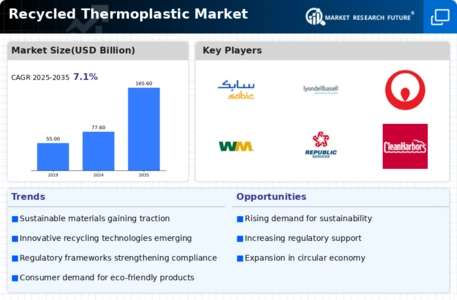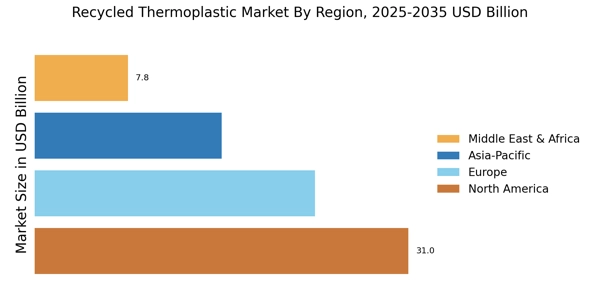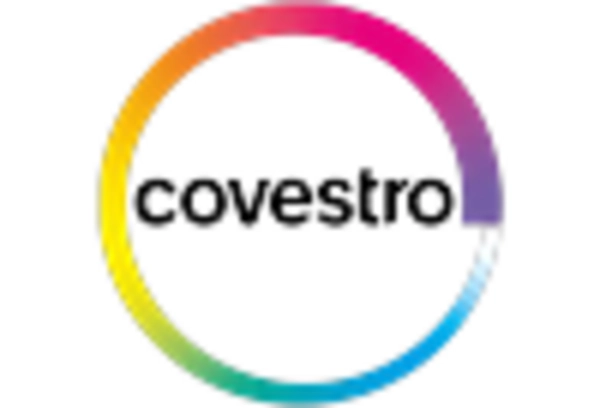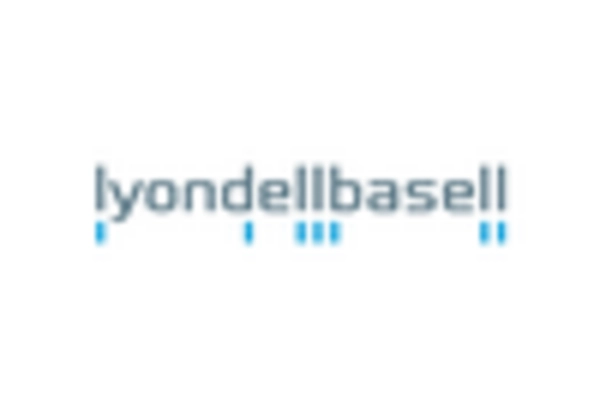Economic Benefits of Recycling
The economic advantages associated with recycling are becoming increasingly apparent within the Recycled Thermoplastic Market. Recycling thermoplastics not only reduces the need for virgin materials but also lowers production costs for manufacturers. By utilizing recycled materials, companies can mitigate fluctuations in raw material prices, which can be volatile. Furthermore, the recycling process often requires less energy compared to producing new plastics, leading to cost savings and reduced carbon footprints. Recent analyses suggest that the economic impact of recycling could lead to the creation of thousands of jobs in the recycling sector, thereby contributing to local economies. As businesses recognize these economic benefits, the Recycled Thermoplastic Market is likely to see continued investment and growth, reinforcing the importance of recycling in achieving both environmental and economic sustainability.
Supportive Regulatory Frameworks
The Recycled Thermoplastic Market is significantly influenced by supportive regulatory frameworks that promote recycling and the use of recycled materials. Governments worldwide are implementing policies aimed at reducing plastic waste and encouraging the adoption of sustainable practices. For example, regulations mandating the use of recycled content in packaging and products are becoming more prevalent. These policies not only create a favorable environment for the growth of the recycled thermoplastic sector but also incentivize manufacturers to invest in recycling technologies. As a result, the market is expected to expand, with projections indicating that the recycled thermoplastic segment could capture a larger share of the overall thermoplastic market by 2027. This regulatory support is crucial for fostering innovation and ensuring the long-term viability of the Recycled Thermoplastic Market.
Rising Consumer Awareness and Preferences
Consumer awareness regarding environmental issues is a driving force in the Recycled Thermoplastic Market. As individuals become more informed about the detrimental effects of plastic pollution, their preferences are shifting towards products made from recycled materials. This trend is particularly evident in sectors such as fashion, where brands are increasingly incorporating recycled thermoplastics into their products to appeal to eco-conscious consumers. Market Research Future indicates that a significant percentage of consumers are willing to pay a premium for sustainable products, further fueling the demand for recycled thermoplastics. Consequently, manufacturers are responding by enhancing their product offerings and marketing strategies to align with consumer values. This evolving landscape presents a substantial opportunity for growth within the Recycled Thermoplastic Market, as companies strive to meet the expectations of a more environmentally aware customer base.
Increasing Demand for Sustainable Materials
The Recycled Thermoplastic Market is experiencing a notable surge in demand for sustainable materials. As consumers and businesses alike become more environmentally conscious, the preference for recycled materials over virgin plastics is intensifying. This shift is driven by a growing awareness of the environmental impact of plastic waste, prompting companies to adopt sustainable practices. According to recent data, the demand for recycled thermoplastics is projected to grow at a compound annual growth rate of approximately 10% over the next five years. This trend indicates a robust market potential for recycled thermoplastics, as industries such as automotive, packaging, and construction increasingly seek eco-friendly alternatives. The Recycled Thermoplastic Market is thus positioned to benefit from this heightened demand, as manufacturers innovate to meet the evolving needs of environmentally aware consumers.
Technological Innovations in Recycling Processes
Technological advancements play a pivotal role in shaping the Recycled Thermoplastic Market. Innovations in recycling processes, such as advanced sorting technologies and chemical recycling methods, are enhancing the efficiency and quality of recycled thermoplastics. These technologies enable the recovery of a wider range of plastics, thereby increasing the supply of recycled materials. For instance, recent developments in depolymerization techniques allow for the breakdown of complex plastics into their original monomers, facilitating higher-quality recycling. As a result, the market is witnessing an influx of high-performance recycled thermoplastics that can compete with virgin materials. This technological evolution not only supports sustainability goals but also drives economic growth within the Recycled Thermoplastic Market, as companies invest in state-of-the-art recycling facilities to meet rising demand.


















Leave a Comment